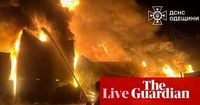Glass crunched underfoot as a camera operator from Radio Free Europe/Radio Liberty (RFE/RL) navigated the charred remains of a passenger train in Shostka, northeastern Ukraine. The aftermath of the Russian missile strike on October 4, 2025, was all too familiar: twisted wreckage, smoldering debris, and a stark reminder of the relentless campaign targeting Ukraine’s railways. This attack was just the latest in a string of over 220 Russian strikes on Ukrainian railway infrastructure since the summer, according to Ukrainian Prime Minister Yulia Svyrydenko, who wrote, “Russians have entered a new stage of barbarism.”
The war in Ukraine, now approaching its fourth year, has seen the country’s rail network become a symbol of resilience and a lifeline for both military and civilian needs. Despite constant threats from Russian drones and missiles, trains continue to move troops, deliver humanitarian aid, and transport grain and metals vital to Ukraine’s economy. Former Infrastructure Minister Volodymyr Omelyan told RFE/RL, “Russia’s desire is obvious: to paralyze Ukrainian logistics, because a significant portion of cargo, including military cargo, uses rail transport.”
Railway hubs, with their concentration of rolling stock and complex logistics, have become prime targets for Russian forces. Omelyan explained that attacks on these hubs are particularly disruptive. “There is a greater concentration of rolling stock at hub stations, and logistics are more complicated there – so hitting hub stations looks more attractive to the Russians,” he said.
Yet the full extent of the disruption remains unclear. Svyrydenko noted that Ukraine’s state-owned rail company has been forced to adjust routes, especially in frontline regions, and sometimes replace trains with buses. On September 17, 2025, for instance, night shelling damaged six major routes serving cities like Dnipro and Kherson. That same night, the Dnipro line was de-energized by a Russian drone attack. Oleksandr Pertsovsky, the chief of Ukrainian railways, described it as “a typical day – or rather night – for Ukrainian railways.” He reassured the public, “Reserve locomotives are on standby, locomotive crews are leaving, they will help minimize delays and traditionally – get everyone to their destination!”
Nearly half of Ukraine’s railway network is electrified, but persistent power outages have forced greater reliance on a limited and aging fleet of diesel locomotives. Recognizing the urgency, Ukraine’s Budget Committee in August approved an expansion of a reserve fund, allowing for swift repairs and continued operations. As Pertsovsky put it, the fund enables the government to “swiftly fund critical repairs and make quick allocations to support Railways’ operational needs.”
The stakes are high. An estimated 60-65 percent of Ukraine’s economic output still moves by rail, making the network a strategic target for Russia. Military equipment, vehicles, metals, iron ore, and grain are all transported by train, sustaining both the war effort and the country’s battered economy. In eastern Ukraine, where roads are often impassable, rail connections are even more crucial. The disruption of rail service doesn’t just affect logistics; it also terrorizes civilians and disrupts passenger traffic. Serhiy Vovk, head of Kyiv’s Center for Transport Strategies, told RFE/RL, “When a train is knocked off its schedule due to damage, it has a domino effect on other train routes, because the schedule is designed in such a way that trains do not stand idle for long.”
Recent days have seen the campaign intensify. On October 7 and 8, Ukrainian railways reported further “enemy attacks” leading to delays, cancellations, and route changes. Fires and damage were reported in the Poltava region. Meanwhile, Russian strikes on energy infrastructure have added another layer of hardship. In Odesa, an overnight drone attack injured five people, cut power to 30,000 consumers, and set containers of vegetable oil and wood pellets ablaze, according to Governor Oleh Kiper.
President Volodymyr Zelenskyy has been vocal about the intent behind these attacks. In comments published by Agence France-Presse (AFP) on October 9, Zelenskyy accused Russia of wanting to sow “chaos” in Ukraine by targeting energy grids and railway lines. “Russia’s task is to create chaos and apply psychological pressure on the population through strikes on energy facilities and railways,” he said. The pattern mirrors previous winters, when Russian bombing campaigns left millions of Ukrainians without energy or heating for extended periods. Zelenskyy warned that continued attacks on gas infrastructure could force Ukraine to increase imports, but he emphasized contingency plans: “Plan A is to rely more on our own extraction. Plan B … is to switch to imports. We understand the volumes, the cost of those imports, and where to get the necessary funds.”
Yet, in a striking turn, Ukraine has begun to hit back with its own campaign of long-range drone and missile strikes on Russian territory. On October 8, Zelenskyy reported that Ukraine’s newly developed Palianytsia missile had struck dozens of Russian military depots, while the Ruta missile drone hit a Russian offshore oil platform more than 150 miles away—a “major success” for the new weapon, he said, according to the Associated Press (AP). Swarms of Liutyi and Fire Point long-range drones, up to 300 in a single operation, have also targeted Russian energy facilities. Ukrainian forces recently fired Neptune and Flamingo missile systems at Russia as well.
The impact has been significant. “The main thing is that [Russia is] now importing gasoline – that’s a signal,” Zelenskyy said. Ukrainian intelligence reports indicate Russia has increased gasoline imports from Belarus sixfold, removed import duties, and started bringing in fuel from China. Zelenskyy estimated, “We believe that they’ve lost up to 20% of their gasoline supply – directly as a result of our strikes.”
On the ground, Ukrainian troops have launched a counteroffensive around Pokrovsk and Dobropillia in the eastern Donetsk region. Zelenskyy described the operation as “very difficult but very timely – and successful,” stating that it derailed Russia’s summer offensive campaign and foiled Moscow’s plan to occupy much of Donetsk by November. Intercepted Russian communications revealed commanders were ordered “to take Pokrovsk at any cost.”
As Ukraine’s railways and energy systems face daily assaults, the government’s ability to adapt and respond has become a matter of survival. The expansion of emergency repair funds, rapid rerouting of trains, and contingency plans for energy supply all underscore the country’s determination to maintain its logistical backbone and economic lifeline under fire.
Meanwhile, Ukraine’s escalating campaign of strikes inside Russia has shifted the dynamics of the conflict, forcing Moscow to scramble for fuel and rethink its own supply lines. The war’s frontlines, both physical and economic, remain fiercely contested—and for now, Ukraine’s battered but unbroken railways continue to carry the weight of a nation at war.




